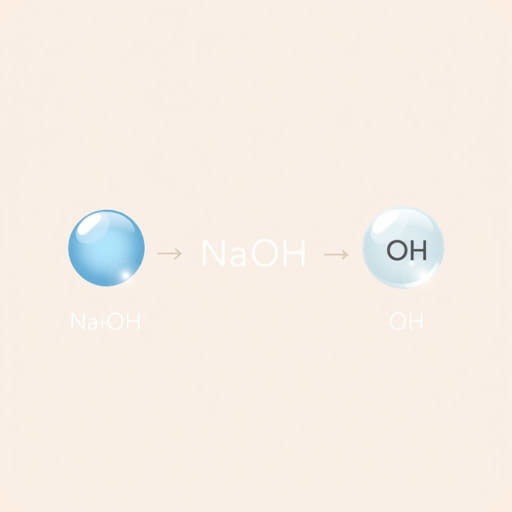When sodium hydroxide (NaOH) is added to water, it undergoes a process known as dissociation. This chemical reaction is fundamental in chemistry, particularly in acid-base interactions, and is crucial for understanding the behavior of strong bases in aqueous solutions. Dissociation of NaOH in water leads to the release of ions that significantly influence the solution’s pH and reactivity. This topic explores in detail how NaOH dissociates in water, what ions are formed, and why this process matters in both laboratory and industrial applications.
Understanding NaOH: A Strong Base
Composition of Sodium Hydroxide
Sodium hydroxide is an ionic compound composed of sodium ions (Naâº) and hydroxide ions (OHâ»). It exists as a solid at room temperature and is highly soluble in water. NaOH is classified as a strong base because it completely dissociates in water, meaning it breaks apart into its ions with no remaining intact molecules of NaOH.
Strong Electrolyte Behavior
NaOH is considered a strong electrolyte due to its complete dissociation in water. This characteristic makes it an excellent conductor of electricity when dissolved in an aqueous solution. Its strong base nature also means that it raises the pH of the solution significantly, making it highly alkaline.
The Dissociation Process of NaOH in Water
Chemical Equation of Dissociation
When NaOH dissolves in water, the following dissociation reaction takes place:
NaOH (s) â Na⺠(aq) + OHâ» (aq)
In this equation, the solid NaOH separates into sodium ions and hydroxide ions upon contact with water. The term aq indicates that the ions are now in an aqueous solution, meaning they are surrounded and stabilized by water molecules.
Mechanism of Dissociation
The dissociation occurs due to the polar nature of water molecules. Water has a partial negative charge near the oxygen atom and a partial positive charge near the hydrogen atoms. These partial charges interact with the positive sodium ions and negative hydroxide ions in NaOH. The water molecules pull the ions away from the solid structure and disperse them evenly throughout the solution.
Ion Hydration
After dissociation, both Na⺠and OH⻠ions become surrounded by water molecules in a process known as hydration. This stabilizes the ions in solution and prevents them from recombining. The Na⺠ion, being positively charged, attracts the oxygen side of water molecules, while the OH⻠ion attracts the hydrogen side.
Effects of NaOH Dissociation on Solution Properties
Increase in pH
Since hydroxide ions (OHâ») are released during dissociation, the solution becomes highly basic. A higher concentration of OHâ» means a higher pH value. For example, a 0.1 M NaOH solution typically has a pH of about 13, which reflects its strong alkalinity.
Electrical Conductivity
The free ions in the solution, especially Na⺠and OHâ», enable the solution to conduct electricity effectively. This makes NaOH solutions useful in electrolysis and other electrical applications in chemistry and industry.
Reactivity with Acids
One of the key features of a solution containing dissociated NaOH is its ability to neutralize acids. The hydroxide ions react with hydrogen ions (Hâº) from acids to form water:
OHâ» (aq) + H⺠(aq) â HâO (l)
This neutralization reaction is the foundation of many titration experiments and acid-base chemistry principles.
Applications of NaOH Dissociation in Real Life
Industrial Uses
Sodium hydroxide’s dissociation plays a vital role in industries such as:
- Paper manufacturing Used in the pulping and bleaching process.
- Soap and detergent production Saponification reactions depend on NaOH’s base strength.
- Water treatment Neutralizes acidic components in water sources.
Laboratory Applications
In laboratory settings, NaOH is a common reagent used in:
- Acid-base titrations
- pH adjustments
- Buffer solution preparation
The predictable dissociation of NaOH makes it a reliable standard in chemical analysis and experiments.
Educational Demonstrations
Due to its straightforward dissociation and strong base properties, NaOH is often used in educational labs to demonstrate chemical principles such as ionic bonding, pH changes, and conductivity.
Safety Considerations When Handling NaOH
Corrosive Nature
Because NaOH dissociates to produce hydroxide ions, which are highly reactive, it is considered a corrosive substance. It can cause severe burns on skin contact and damage mucous membranes upon inhalation or ingestion.
Proper Handling
- Always wear protective gear like gloves, goggles, and lab coats.
- Work in well-ventilated areas or fume hoods.
- In case of skin contact, rinse immediately with plenty of water.
Storage Guidelines
Sodium hydroxide should be stored in tightly sealed containers, away from acids and moisture, as it readily absorbs water and carbon dioxide from the air, which may alter its chemical properties.
Comparing NaOH Dissociation to Other Compounds
Other Strong Bases
Like NaOH, other strong bases such as potassium hydroxide (KOH) and calcium hydroxide (Ca(OH)â) also dissociate completely in water. However, solubility and ion concentration can vary, affecting their practical use and pH levels in solution.
Weak Bases and Incomplete Dissociation
In contrast to NaOH, weak bases like ammonia (NHâ) do not fully dissociate in water. This makes NaOH more predictable and effective when a strong, consistent base is required.
The dissociation of sodium hydroxide in water is a fundamental concept in chemistry that explains how this compound functions as a strong base. Through a simple but powerful ionization process, NaOH splits into sodium ions and hydroxide ions, drastically altering the pH and behavior of the solution. This dissociation is critical in various applications, from industrial manufacturing to classroom experiments. Understanding how NaOH dissociates not only enhances chemical literacy but also underscores the importance of ionic compounds in everyday science and technology.
